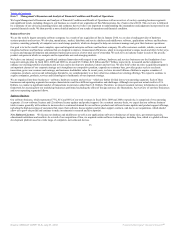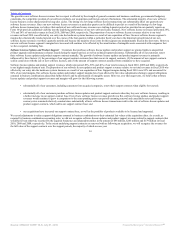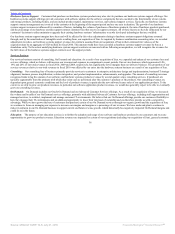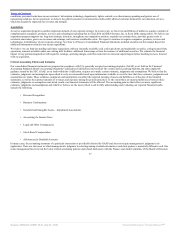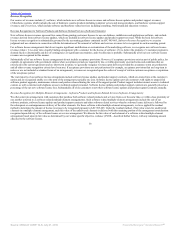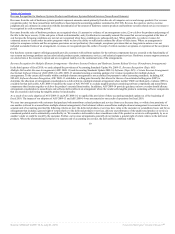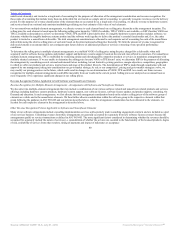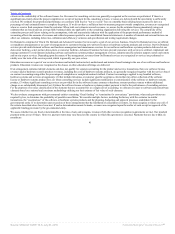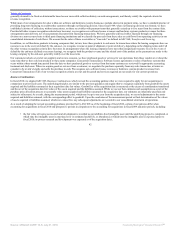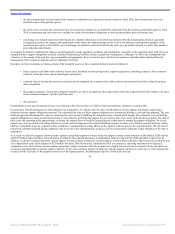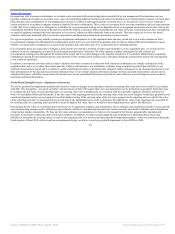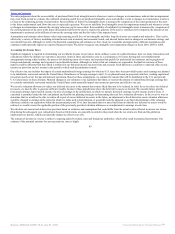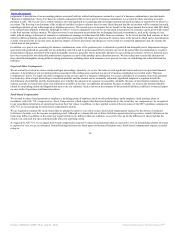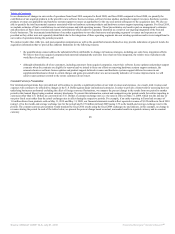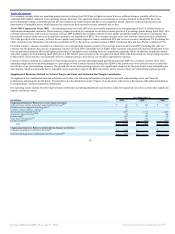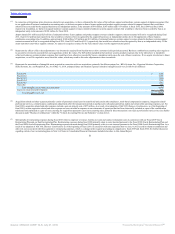Oracle 2009 Annual Report Download - page 47
Download and view the complete annual report
Please find page 47 of the 2009 Oracle annual report below. You can navigate through the pages in the report by either clicking on the pages listed below, or by using the keyword search tool below to find specific information within the annual report.
Table of Contents
• the direct transaction costs associated with a business combination are expensed as incurred (prior to fiscal 2010, direct transaction costs were
included as part of the purchase price);
• the costs to exit or restructure certain activities of an acquired company are accounted for separately from the business combination (prior to fiscal
2010, restructuring and exist costs were included as a part of the assumed obligations in deriving the purchase price allocation); and
• any changes in estimates associated with income tax valuation allowances or uncertain tax positions after the measurement period are generally
recognized as income tax expense with application of this policy also applied prospectively to all of our business combinations regardless of the
acquisition date (prior to fiscal 2010, any such changes in estimates associated with income taxes were generally included as a part of the purchase
price allocation indefinitely).
Accounting for business combinations requires our management to make significant estimates and assumptions, especially at the acquisition date with respect to
intangible assets, support obligations assumed, estimated restructuring liabilities and pre-acquisition contingencies. Although we believe the assumptions and
estimates we have made in the past have been reasonable and appropriate, they are based in part on historical experience and information obtained from the
management of the acquired companies and are inherently uncertain.
Examples of critical estimates in valuing certain of the intangible assets we have acquired include but are not limited to:
• future expected cash flows from software license sales, hardware systems product sales, support agreements, consulting contracts, other customer
contracts and acquired developed technologies and patents;
• expected costs to develop the in-process research and development into commercially viable products and estimated cash flows from the projects
when completed;
• the acquired company’s brand and competitive position, as well as assumptions about the period of time the acquired brand will continue to be used
in the combined company’s product portfolio; and
• discount rates.
Unanticipated events and circumstances may occur that may affect the accuracy or validity of such assumptions, estimates or actual results.
In connection with the purchase price allocations for our acquisitions, we estimate the fair value of both software license updates and product support and
hardware systems support obligations assumed. The estimated fair values of these support obligations are determined utilizing a cost build-up approach. The cost
build-up approach determines fair value by estimating the costs related to fulfilling the obligations plus a normal profit margin. The estimated costs to fulfill the
support obligations are based on the historical direct costs related to providing the support services and to correct any errors in the products acquired. The sum of
these costs and operating profit approximates, in theory, the amount that we would be required to pay a third party to assume the support obligation. We do not
include any costs associated with selling efforts or research and development or the related fulfillment margins on these costs. Profit associated with any selling
efforts is excluded because the acquired entities would have concluded those selling efforts on the support contracts prior to the acquisition date. We also do not
include the estimated research and development costs in our fair value determinations, as these costs are not deemed to represent a legal obligation at the time of
acquisition.
As a result, we did not recognize software license updates and product support revenues related to support contracts in the amounts of $86 million, $243 million
and $179 million that would have been otherwise recorded by the acquired businesses as independent entities in fiscal 2010, 2009 and 2008, respectively. In
addition, we did not recognize hardware systems support revenues related to hardware systems support contracts that would have otherwise been recorded by Sun
as an independent entity in the amount of $128 million for fiscal 2010. Historically, substantially all of our customers, including customers from acquired
companies, renew their software license updates and product support contracts when the contracts are eligible for renewal and we intend to focus our efforts on
renewing acquired hardware systems support contracts. To the extent software support or hardware systems support contracts are renewed, we will recognize the
revenues for the full value of the support contracts over the support periods, the substantial majority of which are one year.
43
Source: ORACLE CORP, 10-K, July 01, 2010 Powered by Morningstar® Document Research℠


